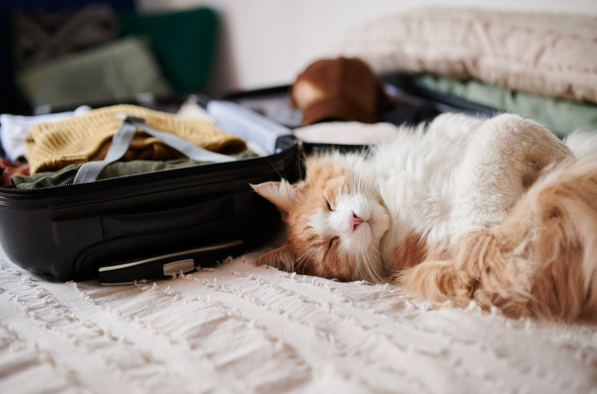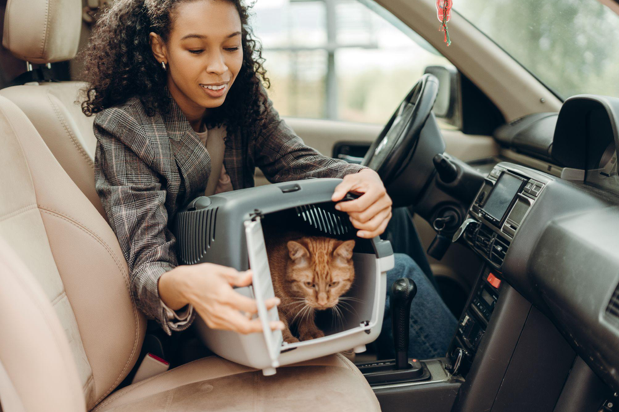Planning a vacation is exciting, but when your furry family member is coming along, there’s more to think about than just where to stay and what to pack.
Traveling with your pet can be safe and enjoyable when you prepare properly. Below, the veterinarians at Newport Mesa Animal Hospital reveal how to make every trip a positive experience for both you and your companion.

10 Rules You Must Follow When Travelling with Your Pets
- Schedule a Vet Exam Before You Go
- Research Pet-Friendly Destinations and Lodging
- Keep Tick and Flea Prevention Updated
- Confirm that Their Identification is Up-to-Date
- Plan for International or Airline Travel
- Prepare a Travel Bag for Your Pet
- Ensure Safe and Comfortable Transportation
- Maintain Your Pet’s Routine
- Monitor for Stress or Health Issues During the Trip
- End the Trip with a Post-Travel Health Check
1. Schedule a Vet Exam Before You Go
Before any trip, schedule a pet wellness exam to confirm that they’re healthy enough for travel, and that their vaccinations are current. Discuss any concerns about motion sickness, anxiety, or dietary adjustments for your destination.
Your veterinarian can also:
- Recommend travel-safe flea and tick prevention.
- Update your pet’s microchip.
- Provide health certificates if you’re traveling across state lines or internationally.
2. Research Pet-Friendly Destinations and Lodging
Every destination has different rules about pets. Look for hotels, campgrounds, or vacation rentals that clearly advertise pet-friendly policies.
Confirm whether there are additional fees or size restrictions before you book. When planning outdoor activities, check that parks and trails allow pets, and that there are shaded, safe areas for rest and hydration.
3. Keep Tick & Flea Prevention Updated
New environments bring unfamiliar parasites, and even indoor pets are at risk during travel. Use veterinarian-approved flea and tick prevention before your trip and maintain the schedule your vet recommends.
For camping or outdoor trips, consider adding protective sprays or repellents that are safe for pets. After returning indoors each day, check your pet’s fur and skin carefully for pests.
4. Confirm that Their Identification is Up-to-Date
Your pet’s microchip and ID tags should have current contact information, including your cell number. Temporary travel tags can be helpful, especially if you’re staying somewhere for an extended period. In case your pet becomes lost, an updated ID increases the likelihood of a safe return.
5. Plan for International or Airline Travel
If you’re traveling abroad, or commuting via airplane, there are additional questions you must ask, such as:
- What are the international travel regulations for pets?
- How do you travel by plane with a dog or cat?
What are the international travel regulations for pets?
Every country sets its own entry requirements, which may include vaccinations, health certificates, rabies antibody titer tests, or even quarantine periods. The U.S. Department of Agriculture (USDA) offers country-specific checklists to simplify the process and reduce stress before departure.

However, there are 4 things you always must do when traveling abroad, regardless of the destination:
- Review destination-specific entry requirements several months in advance.
- Complete all required paperwork with the support of your veterinarian.
- Ensure your pet’s microchip is ISO-compliant.
- Confirm your pet’s vaccinations meet destination guidelines.
How do you travel by plane with a dog or cat?
When travelling by plane with your dog or cat:
- Book early; air travel requires extra coordination, and airlines only allow a small number of pets per flight.
- Always use an airline-approved, well-ventilated carrier that allows them to stand, turn, & lay comfortably.
- Feed your pet a light meal a few hours before the flight, and provide water before boarding.
- Avoid traveling during extreme temperatures; many airlines restrict pet travel in very hot or cold conditions.
- Keep printed & digital copies of vet records, health certificates, & proof of vaccinations on you at all times.
6. Prepare a Travel Bag for Your Pet
Create a pet-specific travel kit to make the trip smoother, as having familiar items from home can help them feel more secure in new surroundings. Be sure to include:
- Food
- Treats
- A water bowl
- Waste bags
- Toys
- A blanket
- Any medications your pet needs
Always pack extra supplies in case of travel delays. Keep your pet’s leash, ID tags, and health documents easily accessible.
7. Ensure Safe and Comfortable Transportation
Your pet’s safety starts with proper restraint during travel. Use a well-ventilated carrier or a seatbelt harness designed for pets.
Never allow your pet to ride unrestrained in the front seat, as airbag deployment can cause serious injuries. Keep car temperature regulated and take frequent breaks to let your pet stretch, hydrate, and relieve themselves.
8. Maintain Your Pet’s Routine
Changes in routine can cause stress. Try to keep feeding times, walks, and rest periods close to what your pet is used to at home.
Offer familiar foods and avoid introducing new treats or diets while away, which can upset digestion. If your trip involves long days of activity, plan downtime for your pet to relax and decompress.
9. Monitor for Stress or Health Issues During the Trip
Research emergency veterinary clinics along your travel route before you leave.
During your trip, watch for signs of anxiety, such as panting, pacing, or whining. Comfort them by speaking calmly and providing gentle reassurance.
Seek veterinary care at your destination if your pet shows unusual behavior, including (but not limited to):
- Loss of appetite
- Vomiting
- Lethargy
10. End the Trip with a Post-Travel Health Check
After returning home, consider scheduling a follow-up vet exam. Travel exposes your pet to new bacteria, parasites, and stressors.
A quick checkup helps to ensure that your pet remains healthy, and that any potential issues are caught early. Your veterinarian can also advise when to resume your pet’s normal flea and tick prevention schedule.
Save Travels with Your Pet: Frequently Asked Questions (FAQs)
What are the TSA’s rules for pet screening?
At security, you’ll remove your pet from the carrier and carry them through the metal detector while the carrier is screened. Always keep your pet leashed or securely held.
You can bring food, water, and small comfort items, but follow the same 3-1-1 liquid rules for any gels or water containers (3.4 ounces, 1 quart-sized bag, 1 bag per passenger).
How do pets go to the bathroom on a plane?
Dogs should use the pet relief area before boarding; for longer flights, line the carrier with an absorbent pad. For cats, place a small disposable litter tray inside the carrier, bring a foldable litter box with extra litter, or use a pad as well. Always clean up promptly and discreetly for everyone’s comfort.
How strict are airlines with carry-on pets?
Airlines are very strict with carry-on pets. They enforce carrier size, weight limits, and documentation requirements closely. Your pet must fit comfortably inside an airline-approved carrier that can slide under the seat, and they must remain inside for the duration of the flight.
What documentation is needed to fly with a pet?
You’ll typically need a recent health certificate from your veterinarian, proof of rabies vaccination, and any airline-specific forms. For international trips, some destinations require microchip documentation, import permits, or rabies antibody tests, so check requirements at least a month in advance.
Is my dog safer in a crate or harness in a car?
A crash-tested crate secured in the back seat or cargo area is safest. If your dog rides in a harness, use one specifically designed for car travel with seatbelt attachments. Don’t let your pet roam freely or ride in your lap.
Is it okay to leave my dog at home for 2 weeks?
Yes it’s okay to leave your dog at home for 2 weeks, but only if your dog’s physical and emotional needs are met. Arrange for a trusted pet sitter, family member, or boarding facility to provide consistent care, exercise, and companionship. Always leave detailed feeding and medication instructions, plus your vet’s contact information.
Discover the Best Way to Travel with Your Pets at Newport Mesa Animal Hospital
Traveling with your pet can strengthen your bond and make family adventures even more meaningful.
With a little preparation and ongoing care, you can keep your pet safe, happy, and healthy wherever the road — or sky — takes you.
If you need expert guidance to ensure that you’ve planned the best way to travel with your furbabies, contact Newport Mesa Animal Hospital today.

